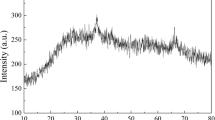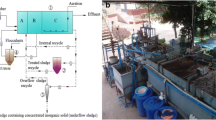Abstract
Lysozyme reaction was developed as a novel technique for minimizing the amount of excess sludge in the sequential batch reactor (SBR). In the present work, excess sludge taken from a SBR system was treated by lysozyme reaction and then returned to the reactor. The quality of the effluent water and characteristics of the activated sludge in the SBR were analyzed to determine the effectiveness of the reduction process. The results show that excess sludge production could be reduced to almost 100% in the first 30 d of operation and could be reduced to further by 40% in the succeeding 20 d or so. In these time periods, the average removal efficiencies of the chemical oxygen demand and total nitrogen are 87.38% and 52.78%, respectively, whereas the average total phosphorous in the effluent is nearly 17.18% greater than that of the effluent of the reference system. After 50 d of operation, the sludge floc size is in the range of 20 to 80 μm, which was smaller than the size prior to the start of the hydrolysis and the ratio of mixed liquor volatile suspended solids/mixed liquor suspended solids increases from 86% to 90%.
Similar content being viewed by others
References
EGEMEN E, CORPENING J, NIRMALAKHANDAN N. Evaluation of an ozonation system for reduced waste sludge generation [J]. Water Sci Technol, 2001, 44: 445–452.
YASUI H, SHIBATA M. An innovative approach to reduce excess sludge production in the activated sludge process [J]. Water Sci Technol, 1994, 30: 11–20.
HUYSMANS A, WEEMAES M, FONSECA PA, VERSTRAETE W. Ozonation of activated sludge in the recycle stream [J]. J Chem Technol Biotechnol, 2001, 76: 321–324.
OH Y K, LEE K R, KO K R, YEOM I T. Effects of chemical sludge disintegration on the performances of wastewater treatment by membrane bioreactor [J]. Water Res, 2007, 41: 2665–2671.
HE S B, XUE G, WANG B Z. Factors affecting the minimization of sludge yield by ozonation process [J]. Chem Eng, 2006, 34: 51–54.
LEE J W, CHA H Y, PARK K Y. Operational strategies for an activated sludge process in conjunction with ozone oxidation for zero excess sludge production during winter season [J]. Water Res, 2005, 39: 1199–11204.
BOHLER M, SIEGRIST H. Partial ozonation of activated sludge to reduce excess sludge, improve denitrification and control scumming and bulking [J]. Water Sci Technol, 2004, 49: 41–49.
CHU L B, YAN S T, XING X H, YU A F, SUN X L. Enhanced sludge solubilization by microbubble ozonation [J]. Chemosphere, 2008, 72: 205–212.
ZHANG G M, ZHANG P Y, YANG J M, CHEN Y M. Ultrasonic reduction of excess sludge from the activated sludge system [J]. J Hazard Mater, 2007, 145: 515–519.
ZHANG G M, HE J G, ZHANG P Y, ZHANG J. Ultrasonic reduction of excess sludge from activated sludge system II: Urban sewage treatment [J]. J Hazard Mater, 2009, 164: 1105–1109.
HE J G, WAN T, ZHANG G M, YANG J. Ultrasonic reduction of excess sludge from the activated sludge system: Energy efficiency improvement via operation optimization [J]. Ultrason Sonochem, 2011, 18: 99–103.
YOON S H, KIM H S, LEE S H. Incorporation of ultrasonic cell disintegration into a membrane bioreactor for zero sludge production [J]. Process Biochem, 2004, 39: 1923–1929.
SABY S, DJAFER M, CHEN G H. Feasibility of using a chlorination step to reduce excess sludge in activated sludge process [J]. Water Res, 2002, 36: 656–666.
TOKUMURA M, SEKINE M, YOSHINARI M, ZNAD H T, KAWASE Y. Photo-Fenton process for excess sludge disintegration [J]. Process Biochem, 2007, 42: 627–633.
LIU Y. Chemically reduced excess sludge production in the activated sludge process [J]. Chemosphere, 2003, 50: 1–7.
CLESCERI L, GREENBERG A, EATON A (Eds.), Standard methods for the examination of water and wastewater [M]. Twentieth ed., Washington, DC: APHA, 2001.
GAO Yan, DAI Xing-chun, CHEN Xi, HUANG Ming. TTC-ETS activity monitoring of A2/O process for combined sewage treatment [J]. Environmental Science, 2009, 30: 153–157.
DYTCZAK M A, LONDRY K L, SIEGRIST H. Ozonation reduces sludge production and improves denitrification [J]. Water Res, 2007, 41: 543–550.
YAN S T, ZHENG H, LI A, ZHANG X, XING X H. Systematic analysis of biochemical performance and the microbial community of an activated sludge process using ozone-treated sludge for sludge reduction [J]. Bioresource Technol, 2009, 100: 5002–5009.
YASUI H, NAKAMURA K, SAKUMA S, IWASAKI M, SAKAI Y. A full-scale operation of a novel activated sludge process without excess sludge production [J]. Water Sci Technol, 1996, 34: 395–404.
SAKAI Y, FUKASE T, YASUI H, SHIBATA M. An activated sludge process without excess sludge production [J]. Water Sci Technol, 1997, 36: 163–170.
Author information
Authors and Affiliations
Corresponding author
Additional information
Foundation item: Project(51078130) supported by the National Natural Science Foundation of China; Project(10C0419) supported by the the Education Department of Hunan Province, China
Rights and permissions
About this article
Cite this article
Song, Y., Shi, Z., Chen, Sy. et al. Feasibility of using lysozyme to reduce excess sludge in activated sludge process. J. Cent. South Univ. 20, 2472–2477 (2013). https://doi.org/10.1007/s11771-013-1759-5
Received:
Accepted:
Published:
Issue Date:
DOI: https://doi.org/10.1007/s11771-013-1759-5




